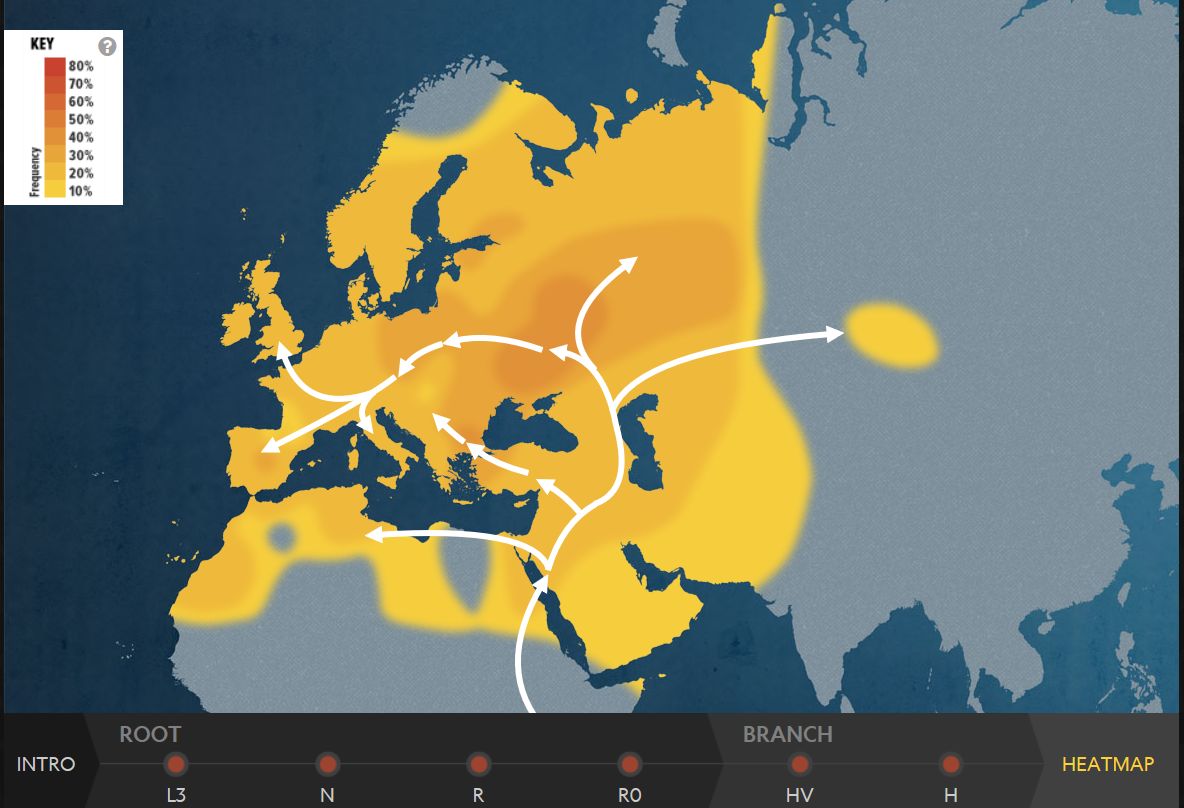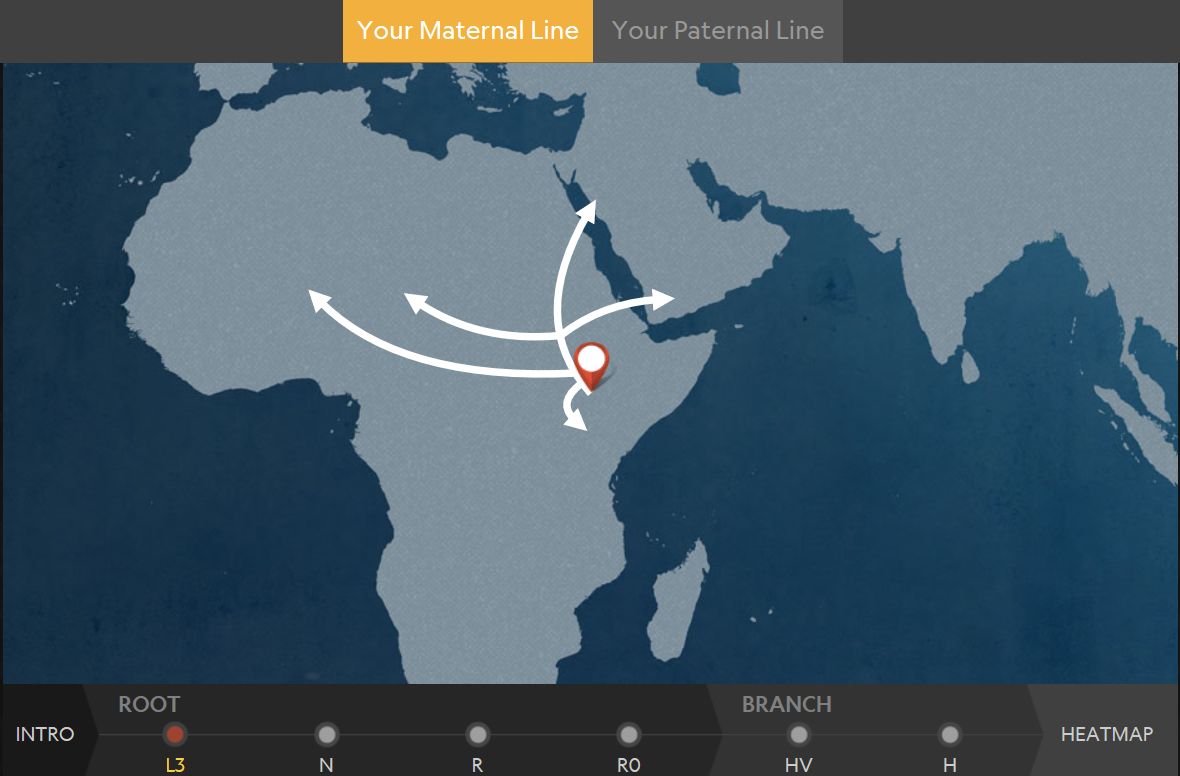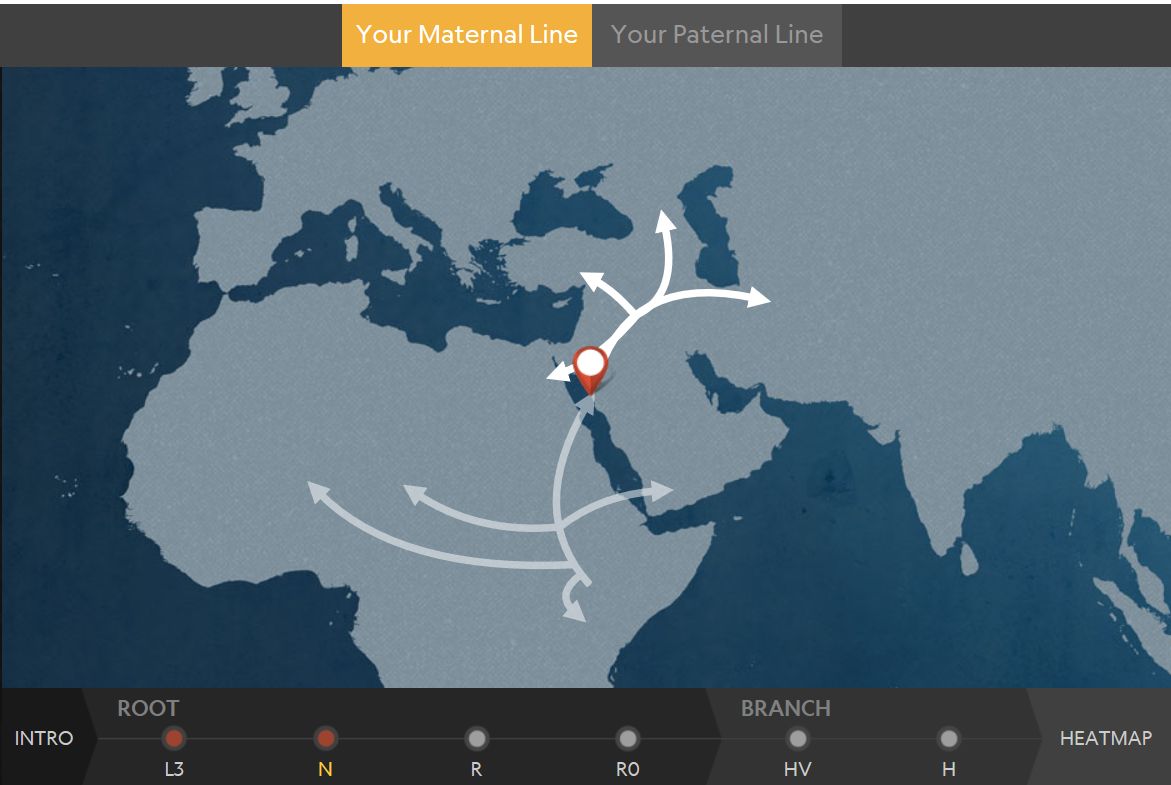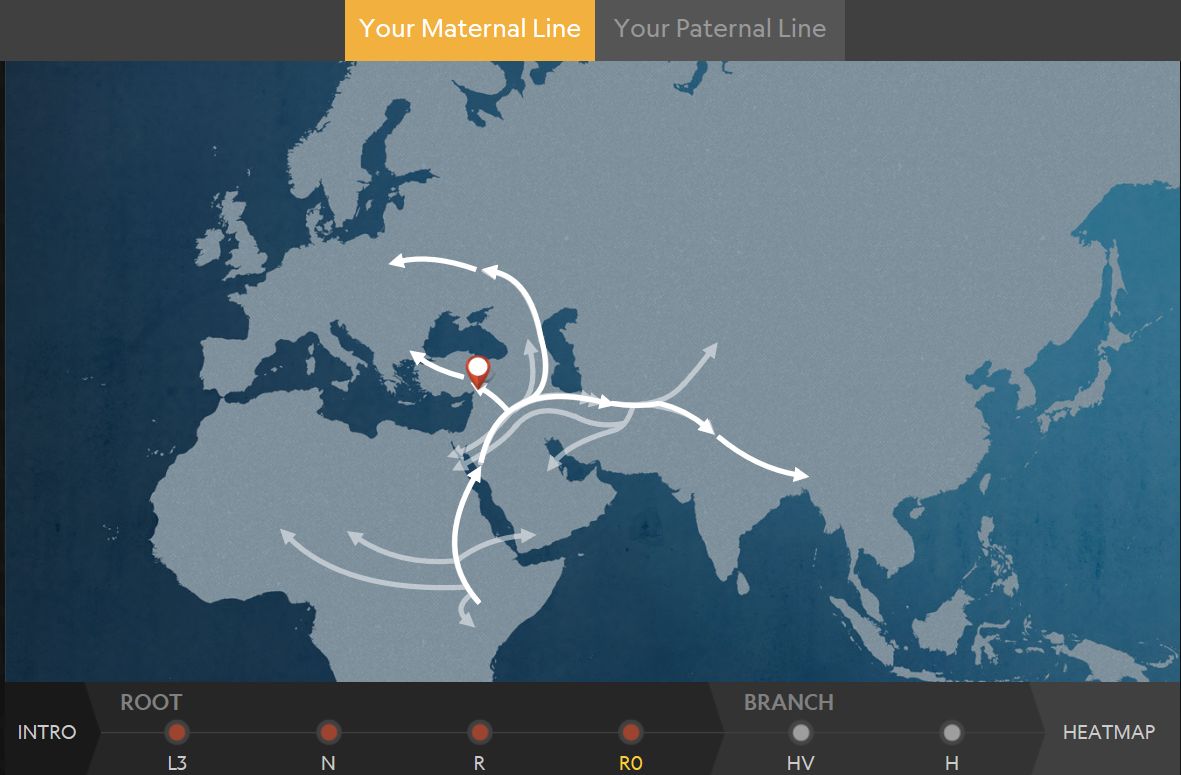Some individuals moved across West Asia into Central Asia and then the Indus Valley. Others moved south, heading back into the African homeland from where their ancestors had recently departed.
Later, members of this lineage moved north across the Caucasus Mountains and west across Anatolia into Europe. These were Cro-Magnon. Their arrival in Europe heralded the end of the era of the Neanderthals.
Today, members of this lineage are present around the Red Sea and widely throughout the region. While this genetic lineage is common in Ethiopia and Somalia, individuals from this group are present at highest frequency in Arabia. Those living in East Africa are the likely result of more recent migrations back into the continent.
Branch: HV
Age: 22,350 ± 7,745 Years Ago
Location of Origin: West Asia

Descending from haplogroup R were a group of individuals who formed a western Eurasian lineage. The descendants of pre-HV live in high frequencies in the Anatolian-Caucasus region and Iran. While members of this group can also be found in the Indus Valley near the Pakistan-India border, their presence is considered the result of a subsequent migration eastward of individuals out of the Near East.
Individuals in haplogroup pre-HV can be found all around the Red Sea and widely throughout the Near East. While this genetic lineage is common in Ethiopia and Somalia, individuals from this group are found at highest frequency in Arabia. Because of their close genetic and geographic proximity to other western Eurasian clusters, members of this group living in eastern Africa are the likely result of more recent migrations back into the continent.
As we have seen from haplogroups N and R, descendants from these western Eurasian lineages used the Near East as a home base of sorts, radiating from that region to populate much of the rest of the world. Their descendants comprise all of the western Eurasian genetic lineages, and about half of the eastern Eurasian mtDNA gene pool. Some individuals moved across the Middle East into Central Asia and the Hindus Valley near western India. Some moved south, heading back into the African homeland from where their ancestors had recently departed.
Haplogroup pre-HV is of particular importance because over the course of several thousand years, its descendants split off and formed their own group, called HV. This group-thanks in large part to a brutal cold spell that was about to set in-gave rise to the two most prevalent female lineages found in Western Europe.
While some descendants of these ancestral lineages moved out across Central Asia, the Indus Valley, and even back into Africa, your ancestors remained in the Near East. Descending from haplogroup pre-HV, they formed a new group, characterized by a unique set of mutations, called haplogroup HV.
Haplogroup HV is a west Eurasian haplogroup found throughout the Near East, including Anatolia (present-day Turkey) and the Caucasus Mountains of southern Russia and the republic of Georgia. It is also found in parts of East Africa, particularly in Ethiopia, where its presence there indicates recent Near Eastern gene flow, likely the result of the Arab slave trade over the last two millennia.
Much earlier, around 30,000 years ago, some members of HV moved north across the Caucasus Mountains and west across Anatolia, their lineages being carried into Europe for the first time by the Cro-Magnon. Their arrival in Europe heralded the end of the era of the Neanderthals, a hominid species that inhabited Europe and parts of western Asia from about 230,000 to 29,000 years ago. Better communication skills, weapons, and resourcefulness probably enabled them to outcompete Neanderthals for scarce resources. Importantly, some descendants of HV had already broken off and formed their own group, haplogroup H, and continued the push into Western Europe.
Today, members of this line are part of the populations of Europe, West Asia (including Anatolia), and the Caucasus Mountains of South Russia and the Republic of Georgia.
This lineage accounts for around 21 percent of maternal lineages in Armenia. It is about 8 percent of those in Turkey and about 5 percent of those in Croatia. Across much of Europe, this line is present at low frequencies of around 1 percent. This lineage accounts for about 7 percent of the population of both India in South Asia and the United Arab Emirates in West Asia.
Branch: H
Age: About 28,000 Years Ago
Location of Origin: West Asia

This wave of migration into western Europe marked the appearance and spread of what archaeologists call the Aurignacian culture, a culture distinguished by significant innovations in methods of manufacturing tools, standardization of tools, and use of a broader set of tool types, such as end-scrapers for preparing animal skins and tools for woodworking.
Around 15,000 to 20,000 years ago, colder temperatures and a drier global climate locked much of the world's fresh water at the polar ice caps, making living conditions near impossible for much of the northern hemisphere. Early Europeans retreated to the warmer climates of the Iberian Peninsula, Italy, and the Balkans, where they waited out the cold spell. Their population sizes were drastically reduced, and much of the genetic diversity that had previously existed in Europe was lost.
Beginning about 15,000 years ago-after the ice sheets had begun their retreat-humans moved north again and recolonized western Europe. By far the most frequent mitochondrial lineage carried by these expanding groups was haplogroup H. Because of the population growth that quickly followed this expansion, your haplogroup now dominates the European female landscape.
Today haplogroup H comprises 40 to 60 percent of the gene pool of most European populations. In Rome and Athens, for example, the frequency of H is around 40 percent of the entire population, and it exhibits similar frequencies throughout western Europe. Moving eastward the frequencies of H gradually decreases, clearly illustrating the migratory path these settlers followed as they left the Iberian Peninsula after the ice sheets had receded. Haplogroup H is found at around 25 percent in Turkey and around 20 percent in the Caucasus Mountains.
While haplogroup H is considered the Western European lineage due to its high frequency there, it is also found much further east. Today it comprises around 20 percent of southwest Asian lineages, about 15 percent of people living in Central Asia, and around five percent in northern Asia.
Importantly, the age of haplogroup H lineages differs quite substantially between those seen in the West compared with those found in the East. In Europe its age is estimated at 10,000 to 15,000 years old, and while H made it into Europe substantially earlier (30,000 years ago), reduced population sizes resulting from the glacial maximum significantly reduced its diversity there, and thus its estimated age. In Central and East Asia, however, its age is estimated at around 30,000 years old, meaning your lineage made it into those areas during some of the earlier migrations out of the Near East.
Haplogroup H is a great example of the effect that population dynamics such as bottleneck events, founder effect, genetic drift, and rapid population growth, have on the genetic diversity of resulting populations.
Later migrations, such as those during the Neolithic Revolution and those triggered by the Bronze Age, brought additional groups containing different descendant branches of this line to Europe.
Heatmap for H

This next step in your journey is a map showing the frequency of your haplogroup (or the closest haplogroup in your path that we have frequency information for) in indigenous populations from around the world, providing a more detailed look at where some of your more recent ancestors settled in their migratory journey. What do we mean by recent? It's difficult to say, as it could vary from a few hundred years ago to a few thousand years ago depending on how much scientists currently know about your particular haplogroup. As we test more individuals and receive more information worldwide, this information will grow and change.
The colors on the map represent the percentage frequency of your haplogroup in populations from different geographic regions-red indicates high concentrations and light yellow and grey indicate low concentrations. The geographic region with the highest frequency isn't necessarily the place where the haplogroup originated, although this is sometimes the case.
The map for H shows that it is widespread in western Eurasia and North Africa with a peak frequency in north-Central Africa and Europe. H is the most common mitochondrial haplogroup in western Eurasia.
Does this mean you're related to people in the areas highlighted on your map? Distantly, yes! We are all connected through our ancient ancestry. In order for us to learn more ancestry information about where haplogroups settled in more recent times, please choose to contribute your results to science (check the checkbox during Login or from the Account Settings tab of your Profile), and fill out your ancestry information in the Profile section of the site. Also be sure to tell your own story in the Our Story section.



